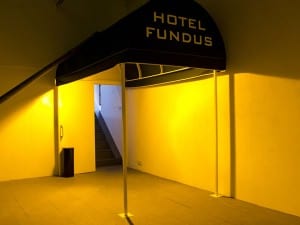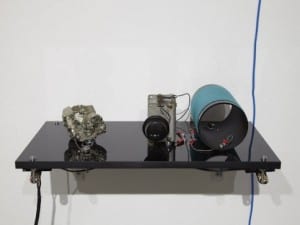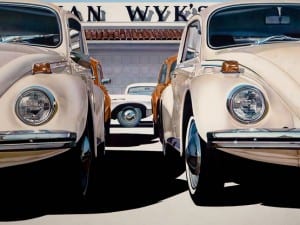The Ikon Gallery’s current exhibition, Tapa – Barkcloth paintings from the Pacific, proposes a curious offering for a contemporary art gallery. However once inside the space, a timeless partnership, which transgresses history and the furthest reaches of the globe, is erected with the second show by François Morellet, which richly demands further exploration.
Tapa is an amalgamation produced by the soaking and beating of the inner bark of specific trees, most commonly the Paper Mulberry found in the pacific islands. The results from this process are decorated with simplistic yet intricate optical patterns. The thin sheets of Tapa are spaciously presented around the gallery. From the far end of the gallery natural light lures the viewer in and, as the light seeps on to the white walls, an intensifying luminosity is born. This unmitigated display yields to the work’s organic surface quality and production process. As these are combined with the glow from the walls, the viewer is brought into a symphony of tranquil reflection. Aitutaki (circa 1900) sees a long horizontal sheet of deep terracotta coloured Barkcloth. Upon it are wildly marked columns full of repetitive shapes and designs arranged in an almost symmetrical manner – thick black lines bristling with personification and character. Quickly, a link is overheard, making reference to abstract expressionism, with an abstract sense of hindsight, to Robert Motherwell’s paintings.
For most people Tapa will be a largely unknown art form and thus can easily be dismissed because of its unknown place within Western Art. Yet the reflective tendencies brought on by the curation, as witnessed, allows for this surreal dialogue to be opened up freely. This is greatly achieved through large areas of open space between paintings, which offers a breathing room when viewing each work. Similarly the subtle soothing of the natural light further boasts the power to rid the analytical and artificial restraints of the gallery to a more organic and natural placing of the work. Thus, one effortlessly finds themselves building reference points of similarity between the past two hundred years of art and the Tapa.
The context and consequential atmosphere takes a sharp turn as one continues on to the second floor gallery. This part of the exhibition is comprised of a selection of paintings made in 2006 by French painter François Morellet, which are replicas of works produced in 1952 to a scale of 4:1. The paintings’ blend of optical illusion and repetition of abstracted pattern is an aesthetic far more familiar to the settings of a contemporary gallery, yet, having experienced the Tapa exhibition, they become entangled in an infatuating relationship with the aesthetics properties of the Tapa. Parallels (2006) shows a long horizontal canvas, displaying a series of thin yellow lines interrupted by three blue horizontal lines in differing proximities to one another. This creates an illusion to the displacement of space as it is suspended in perpetual movement. These simplistic and fauvist patterns encompass the space in the same diluted manner as the first floor, except for achieving an undertone of isolation rather than reflection – perhaps a metaphor for the evolution of the artist. From community orientated symbolism to the intellectual progression of lonesome painter.
Tapa – Barkcloth paintings from the Pacific, until 14 July at Ikon Gallery, 1 Oozells Square, Brindleyplace, Birmingham, B1 2HS.
William Davie
Credits
1. Courtesy of the Ikon Gallery.





